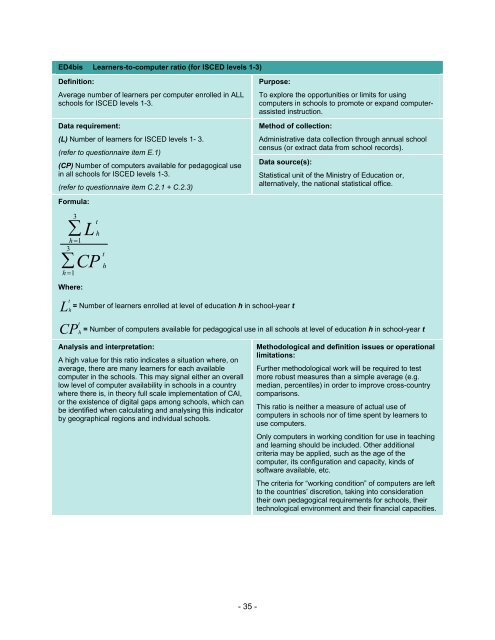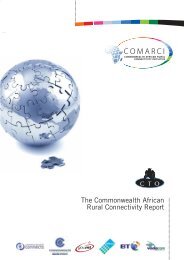Guide to measuring information and ... - unesdoc - Unesco
Guide to measuring information and ... - unesdoc - Unesco
Guide to measuring information and ... - unesdoc - Unesco
Create successful ePaper yourself
Turn your PDF publications into a flip-book with our unique Google optimized e-Paper software.
ED4bis Learners-<strong>to</strong>-computer ratio (for ISCED levels 1-3)<br />
Definition:<br />
Average number of learners per computer enrolled in ALL<br />
schools for ISCED levels 1-3.<br />
Data requirement:<br />
(L) Number of learners for ISCED levels 1- 3.<br />
(refer <strong>to</strong> questionnaire item E.1)<br />
(CP) Number of computers available for pedagogical use<br />
in all schools for ISCED levels 1-3.<br />
(refer <strong>to</strong> questionnaire item C.2.1 + C.2.3)<br />
Formula:<br />
3<br />
L<br />
h 1<br />
3<br />
CP<br />
h 1<br />
Where:<br />
t<br />
h<br />
t<br />
h<br />
- 35 -<br />
Purpose:<br />
To explore the opportunities or limits for using<br />
computers in schools <strong>to</strong> promote or exp<strong>and</strong> computerassisted<br />
instruction.<br />
Method of collection:<br />
Administrative data collection through annual school<br />
census (or extract data from school records).<br />
Data source(s):<br />
L t<br />
= Number of learners enrolled at level of education h in school-year t<br />
h<br />
Statistical unit of the Ministry of Education or,<br />
alternatively, the national statistical office.<br />
CP t<br />
h = Number of computers available for pedagogical use in all schools at level of education h in school-year t<br />
Analysis <strong>and</strong> interpretation:<br />
A high value for this ratio indicates a situation where, on<br />
average, there are many learners for each available<br />
computer in the schools. This may signal either an overall<br />
low level of computer availability in schools in a country<br />
where there is, in theory full scale implementation of CAI,<br />
or the existence of digital gaps among schools, which can<br />
be identified when calculating <strong>and</strong> analysing this indica<strong>to</strong>r<br />
by geographical regions <strong>and</strong> individual schools.<br />
Methodological <strong>and</strong> definition issues or operational<br />
limitations:<br />
Further methodological work will be required <strong>to</strong> test<br />
more robust measures than a simple average (e.g.<br />
median, percentiles) in order <strong>to</strong> improve cross-country<br />
comparisons.<br />
This ratio is neither a measure of actual use of<br />
computers in schools nor of time spent by learners <strong>to</strong><br />
use computers.<br />
Only computers in working condition for use in teaching<br />
<strong>and</strong> learning should be included. Other additional<br />
criteria may be applied, such as the age of the<br />
computer, its configuration <strong>and</strong> capacity, kinds of<br />
software available, etc.<br />
The criteria for “working condition” of computers are left<br />
<strong>to</strong> the countries’ discretion, taking in<strong>to</strong> consideration<br />
their own pedagogical requirements for schools, their<br />
technological environment <strong>and</strong> their financial capacities.
















